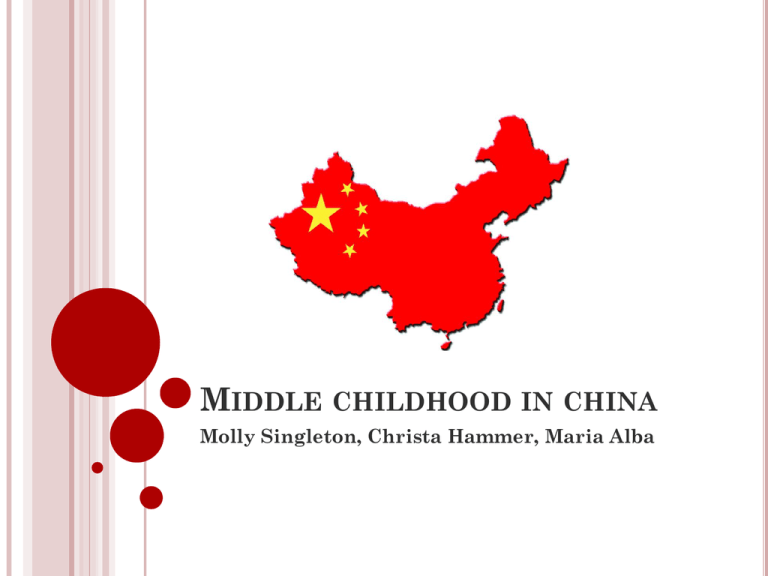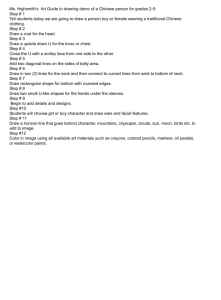Middle childhood in china
advertisement

MIDDLE CHILDHOOD IN CHINA Molly Singleton, Christa Hammer, Maria Alba CHINA AT A GLANCE Fun Facts • People’s Republic of China • Capital City: Beijing • Chinese Communist Party • Renminbi is the official currency • Mandarin Chinese • Buddhism and Taoism • Infant Mortality Rate: 15.62 deaths/1,000 live births (2013) • Literacy rate is 92.2% • Ranked world’s 2nd largest economy by GDP International Children’s Day PHYSICAL DEVELOPMENT AVERAGE HEIGHT AND WEIGHT FOR U.S. CHILDREN Height Weight 6 year old boy: 3 ft. 8 11 year old boy: 4 ft. 5 6 year old boy: 43 lbs. 11 year old boy: 80 lbs. 6 year old girl: 3 ft. 7 11 year old girl: 4 ft. 7 6 year old girl: 42 lbs. 11 year old girl: 82 lbs. PUBERTY Average age to hit puberty is age 10 for girls and 12 for boys. WHY? Increase of estrogen intake (girls) Higher use of pesticides in vegetables and fruit, which can decompose into elements with high sex hormones Pollution COGNITIVE DEVELOPMENT- THEORY OF MIND Universal? Timing across cultures and languages False Beliefs Beliefs, Appearance, Thoughts Understanding Theory of Mind Think about Intersecting Variables COGNITIVE DEVELOPMENT- LEARNING Rigid School Schedule Challenges with basic word-reading skills Phonological Awareness, Writing, Homophones Executive Functioning Mental Functions, Behavior, Self- Control Reading problems- Verbal Memory Skills Chinese vs U.S Children Heavy emphasis on school and academics Executive Functioning Scores Math Scores Lots of Homework, Extra work at home Stress and Social Pressures PSYCHOSOCIAL DEVELOPMENT Social Impact of The One Child Policy Study of Self concept, appearance, and academics Son Preference Impact Confucian Ritualization REFERENCE PAGE China Infant mortality rate - Demographics. (2013, February 21). Index Mundi. Chung, K. H., & McBride-Chang, C. (2011). Executive functioning skills uniquely predict Chinese word reading. Journal Of Educational Psychology, 103(4), 909-921. doi:10.1037/a0024744 Dong, F., & Jensen, H. H. (2008). New evidence on overweight children in urban china and the role of socioeconomic factors. Fan, R. (2012). Confucian ritualization: How and why?. In Ritual and The Moral Life (pp. 143-158). New York, NY: Springer. Growth charts for Chinese children. (2010, November). High early puberty rates in china alarm doctors. (2010, April 20). Hudson-Ross, S. (1990). Literacy learning as a reflection of language and culture: Chinese elementary school education. Reading Teacher, 44(2), 110. Leong, C., Tse, S., Loh, K., & Hau, K. (2008). Text comprehension in Chinese children: Relative contribution of verbal working memory, pseudoword reading, rapid automatized naming, and onset-rime phonological segmentation. Journal Of Educational Psychology, 100(1), 135-149. doi:10.1037/0022-0663.100.1.135 Liu, D., Wellman, H. M., Tardif, T., & Sabbagh, M. A. (2008). Theory of mind development in Chinese children: A meta-analysis of false-belief understanding across cultures and languages. Developmental Psychology, 44(2), 523-531. doi:10.1037/0012-1649.44.2.523 National Center of Health Statistics, & National Center for Chronic Disease Prevention and Health Promotion. (2000, May 20). 2 to 20 years: girls stature-for-age-and weight-for age percentiles. National Center of Health Statistics, & National Center for Chronic Disease Prevention and Health Promotion. (2000, May 30). 20 to 20 years: boys stature-for- age and weight-for-age percentiles. Sing, L., Wing Ling, L., Xianmei, C., Gong, C., & Siu, C. K. (1998). The Self-Perception Of Ability by Chinese Children in China and Hong Kong: Gender and Grade Differences. Social Behavior & Personality: An International Journal, 26(3), 275. Tao, K. (1998). An overview of only child family mental health in China. Psychiatry And Clinical Neurosciences, 52 SupplS206-S211. Wendy, W. (2005). Son Preference and Educational Opportunities of Children in China-- "I Wish You Were a Boy!". Gender Issues,22(2), 3-30. Xuefeng, C. (2003). The Social Impact of China's One-Child Policy. Harvard Asia Pacific Review, 7(1), 74-76. Zhang, Y., Tardif, T., Shu, H., Li, H., Liu, H., McBride-Chang, C., & ... Zhang, Z. (2013). Phonological skills and vocabulary knowledge mediate socioeconomic status effects in predicting reading outcomes for Chinese children. Developmental Psychology, 49(4), 665-671. doi:10.1037/a0028612






